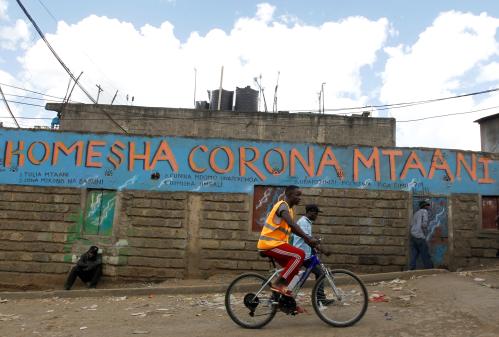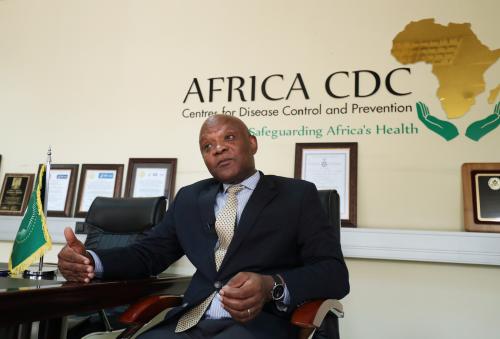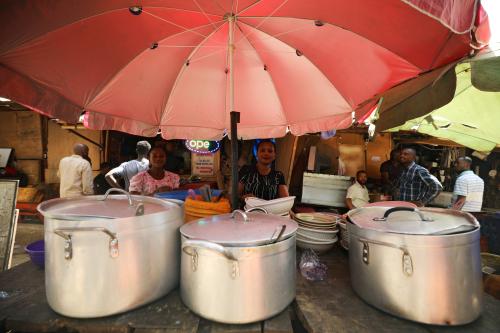International community looks to support Africa with debt relief, health aid
This week, the G-20 nations agreed to suspend bilateral debt service payments until the end of the year for 76 low-income countries eligible for the World Bank’s most concessional lending via the International Development Association. The list of eligible countries includes 40 sub-Saharan African countries. Notably, Angola and South Africa are not included as they borrow from the International Bank for Reconstruction and Development, the World Bank Group organization that lends to middle-income countries. In total, $20 billion in debt service payments will be suspended, including $8 billion from private sector creditors. In a statement, the G-20 called on other private lenders to voluntarily “participate in the initiative on comparable terms.” For more on the call for debt relief in Africa, see the recent Project Syndicate piece, “Africa needs debt relief to fight COVID-19,” by AGI Director Brahima S. Coulibaly and co-authors.
In related news, the International Monetary Fund (IMF) approved six months of debt service relief for 25 low-income countries, including 19 in Africa. The suspension of the IMF’s debt service is through the institution’s Catastrophe Containment and Relief Trust and can be extended up to two years. In addition to this move, the IMF also approved additional funding support for several African countries, including Chad, Ghana, and Senegal. For more on the predicted fiscal fallout of COVID-19 in Africa, see this week’s “Figures of the week: The macroeconomic impact of COVID-19 in Africa.”
The international community and bilateral partners are also looking to support Africa in other ways during this crisis. For example, on Tuesday, the European Union announced a 50 million euro ($54 million) donation to Nigeria to support the country’s efforts to fight COVID-19. On Friday, Indian Prime Minister Narendra Modi promised to send essential medical supplies to South Africa.
African governments take varying approaches to mitigate the spread of COVID-19
Meanwhile, outside of the global response, national and regional governments across the continent continue to address the COVID-19 pandemic in different ways.
All in all, the number of cases in the region has risen, with over 12,300 confirmed cases as of this writing. However, many local officials have been expressing hope that measures are indeed “flattening the curve” in some countries.
Meanwhile, Libya announced a 10-day lockdown starting Saturday, April 18, which will ban cars on the road and shut down all large markets, nonessential shops, and banks. Only citizens wearing masks will be allowed outdoors between the hours of 8 a.m. and 2 p.m. Meanwhile, efforts to push for a ceasefire in the country’s civil war continue.
In Malawi, thousands of informal workers took to the streets to protest the government’s newly announced 21-day lockdown measures—scheduled to go into effect this weekend—stating that the new measures, which prevent the workers from earning income, will in turn cause these workers and their families to go hungry. In fact, without enhanced social safety nets, the livelihoods and lives of informal workers and their families across the region are under threat. For more on the plight of microentrepreneurs and informal workers in Africa under COVID-19, see “Social distancing unlikely to hold up in Africa without a safety net for microentrepreneurs.”
Meanwhile, Uganda has extended its lockdown and ban on public transportation until May 5. Its borders and airports remain closed to all except cargo and emergency flights. The country, like many others, has credited its past experience with Ebola for its relative success in containing the virus.
Notably, in order to slow the spread of the virus in prisons, both Botswana and Cameroon have announced large-scale prisoner releases in the forms of pardons and/or sentence reductions.
Earlier this week, Guinea announced that the wearing of masks in public would now be mandatory, with violators facing a fine of 30,000 Guinean francs (about $3). Kenya announced a similar measure this week, threatening a fine of 20,000 Kenyan shillings (about $200) and/or a jail term of six months for offenders.
In positive news, Kenya, South Africa, and Zimbabwe, among other countries, have announced widespread, mass testing efforts. In addition, on Thursday, the African Union’s Africa Centers for Disease Control and Prevention (Africa CDC) announced a plan to distribute 1 million testing kits across the continent. Though far more kits are needed on the populous continent, officials seem positive, as Africa CDC director Dr. John Nkengasong says, “Over the next three months or six months, we probably need like 15 million tests, however, a journey of 1,000 miles starts with the first mile.” For more on the role of the Africa CDC and strategies for empowering it, see “The coming of age of the Africa Centers for Disease Control.”
South African government cuts off funding for national airline, updates economic outlook
This week, the South African government declined to extend further loan guarantees to South African Airways, the state-owned national airline. Reuters reports that the closing of the state-owned airline is part of the finance minister’s fiscal response plan to COVID-19. South African Airways has been struggling to be profitable for years and is currently going through a protected bankruptcy process that it entered in December 2019. As of now, it is unclear how the cut-off in funding will impact the protected bankruptcy process.
In other economic news, South Africa’s central bank updated its GDP forecast with 2020 growth at -6.1 percent and an expected rebound for the economy in 2021 and 2022 with growth at 2.2 and 2.7 percent, respectively. This week, the central bank also cut its key lending rate by 1 percentage point, to 4.25 percent—the lowest in its history. As part of its response to COVID-19, the South African Reserve Bank is running a bond-buying program to support credit markets. The bank is also expected to launch other programs to support the economy in the coming weeks.
The Brookings Institution is committed to quality, independence, and impact.
We are supported by a diverse array of funders. In line with our values and policies, each Brookings publication represents the sole views of its author(s).









Commentary
Africa in the news: African governments, multilaterals address COVID-19 emergency, debt relief
April 18, 2020